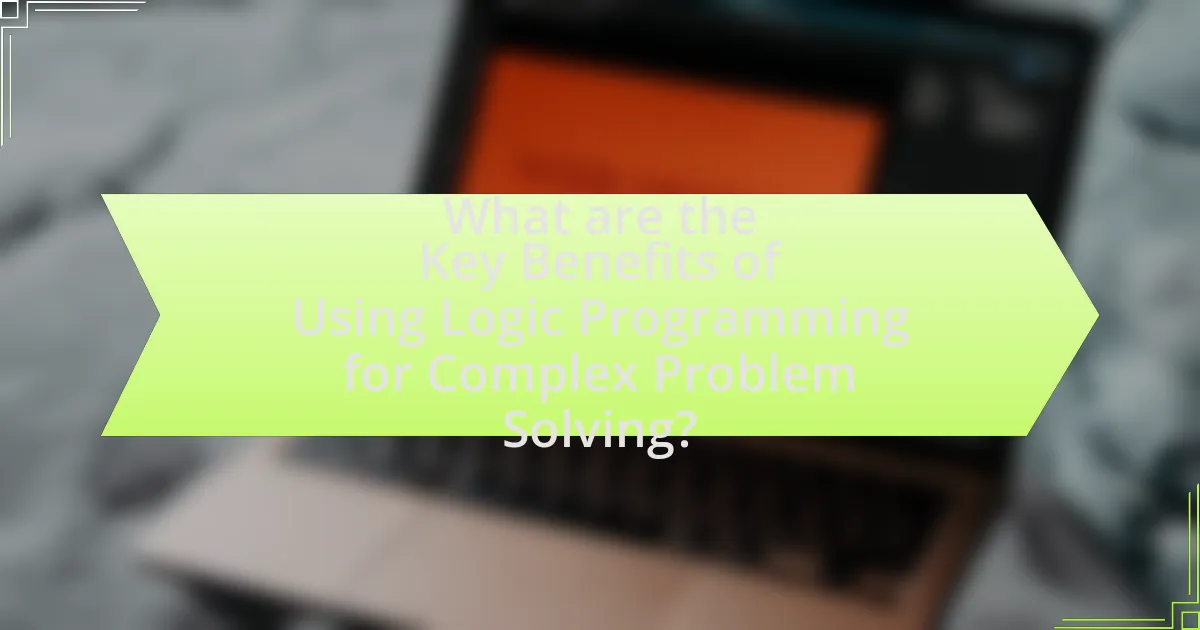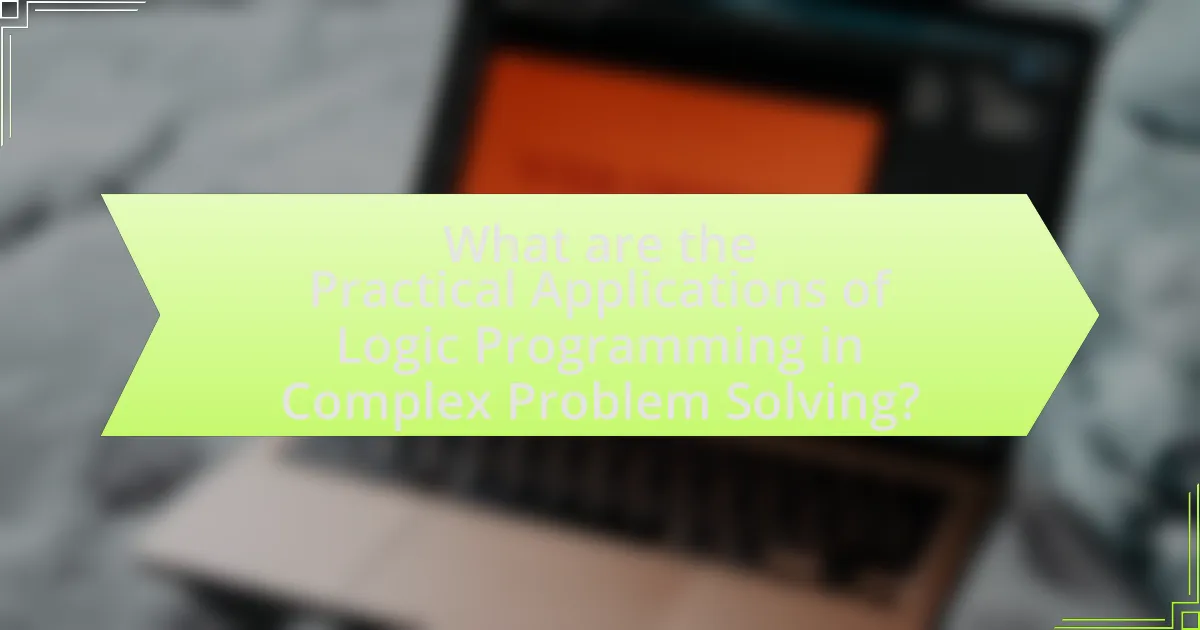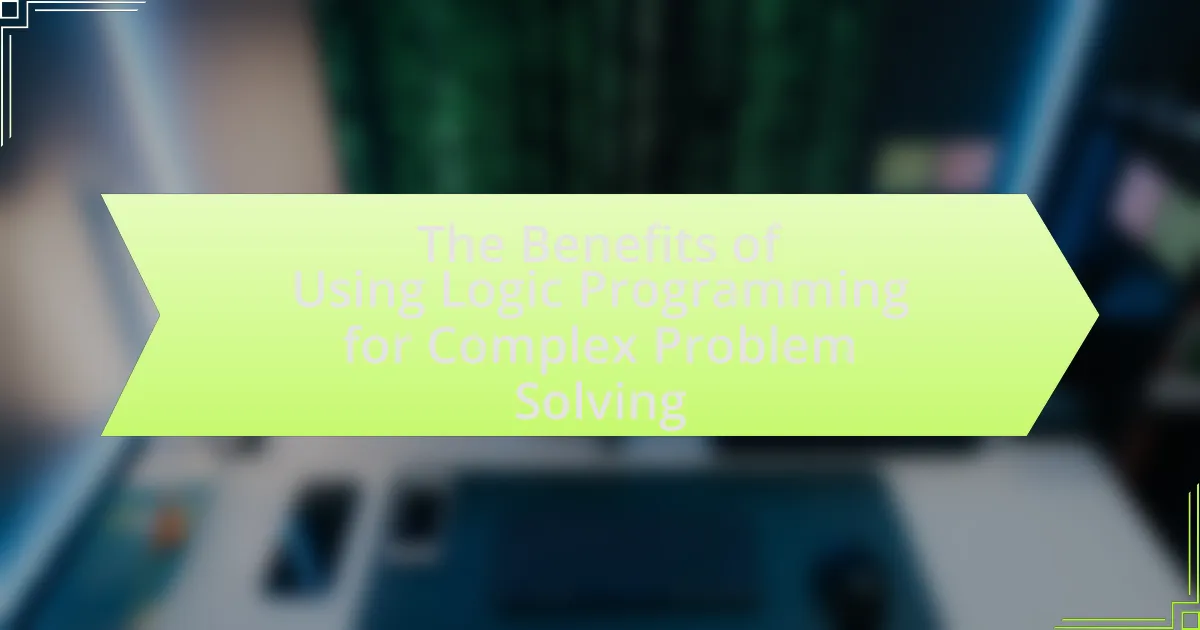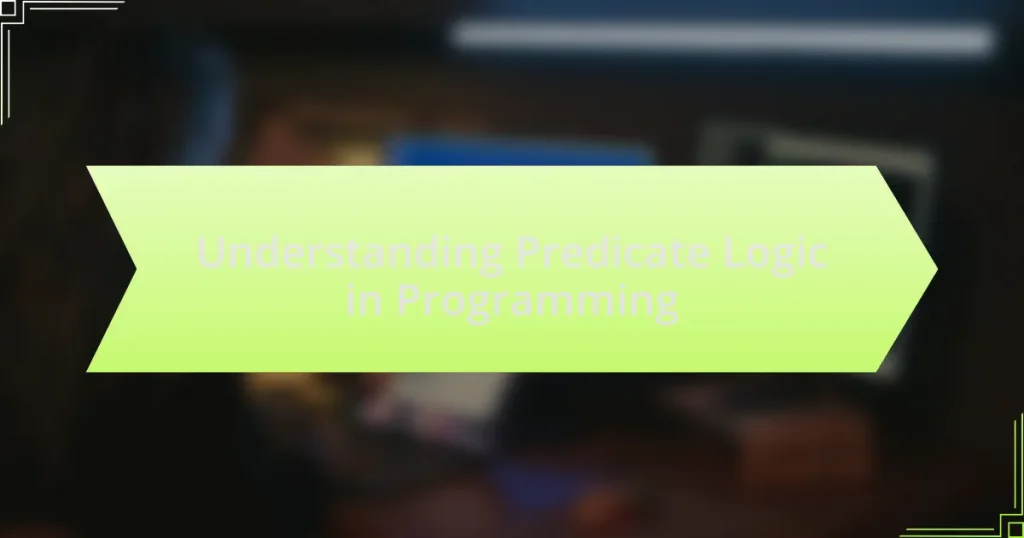Logic programming is a programming paradigm rooted in formal logic, enabling the expression of programs through relations and logical inference. This article explores the benefits of logic programming for complex problem solving, highlighting its declarative nature, automated reasoning capabilities, and effectiveness in managing constraints. Key applications in artificial intelligence, natural language processing, and knowledge representation are discussed, along with the fundamental principles that differentiate logic programming from other paradigms. Additionally, the article addresses challenges practitioners face and offers best practices for effective implementation, emphasizing the role of logic programming in enhancing collaboration and communication among stakeholders.

What is Logic Programming and How Does it Relate to Complex Problem Solving?
Logic programming is a programming paradigm based on formal logic, where programs are expressed in terms of relations, and computation is performed through logical inference. This approach is particularly effective for complex problem solving as it allows for the representation of problems in a declarative manner, enabling the programmer to focus on what the solution should achieve rather than how to achieve it.
For instance, Prolog, a well-known logic programming language, facilitates the development of algorithms for problems such as scheduling, natural language processing, and knowledge representation by allowing users to define rules and facts. The ability to express complex relationships and constraints succinctly makes logic programming a powerful tool for tackling intricate problems that require reasoning and deduction.
How does logic programming function in the context of problem solving?
Logic programming functions in the context of problem solving by allowing the expression of problems in terms of relations and rules, enabling automated reasoning to derive solutions. This paradigm uses a formal system where facts and rules are defined, and a query mechanism is employed to infer conclusions based on these definitions. For example, Prolog, a widely used logic programming language, allows users to define relationships and rules, which the system then uses to answer queries through backtracking and unification. This method is particularly effective for complex problems, such as those found in artificial intelligence and knowledge representation, as it simplifies the process of finding solutions by focusing on what is true rather than how to achieve it.
What are the fundamental principles of logic programming?
The fundamental principles of logic programming include the use of formal logic to express facts and rules about a problem domain, the execution of programs through a process of logical inference, and the reliance on a declarative programming paradigm where the focus is on what the program should accomplish rather than how to accomplish it. Logic programming is based on the principles of resolution and unification, which allow for automated reasoning and problem-solving. These principles enable systems like Prolog to derive conclusions from given facts and rules, facilitating complex problem-solving tasks effectively.
How does logic programming differ from other programming paradigms?
Logic programming differs from other programming paradigms primarily in its approach to problem-solving, which is based on formal logic rather than procedural or object-oriented methods. In logic programming, such as in languages like Prolog, programs consist of a set of facts and rules that define relationships and constraints, allowing the system to infer conclusions through a process of logical deduction. This contrasts with imperative programming, where the focus is on explicitly defining a sequence of operations to achieve a result, and with object-oriented programming, which centers around the manipulation of objects and their interactions. The declarative nature of logic programming enables it to express complex problems succinctly and allows for automatic reasoning, making it particularly effective for applications in artificial intelligence, knowledge representation, and complex problem-solving scenarios.
What types of complex problems can be addressed using logic programming?
Logic programming can address complex problems such as constraint satisfaction, natural language processing, and knowledge representation. These problems often involve intricate relationships and dependencies that can be effectively modeled using logical rules and facts. For instance, in constraint satisfaction problems, logic programming allows for the specification of constraints and the exploration of possible solutions, as demonstrated in applications like scheduling and resource allocation. In natural language processing, logic programming facilitates the parsing and understanding of human language through formal grammar representations. Additionally, knowledge representation in artificial intelligence benefits from logic programming by enabling the encoding of complex relationships and reasoning about them, as seen in expert systems and semantic web technologies.
Which domains benefit from logic programming in problem solving?
Logic programming benefits several domains, including artificial intelligence, natural language processing, database systems, and automated theorem proving. In artificial intelligence, logic programming facilitates knowledge representation and reasoning, enabling systems to make inferences based on rules and facts. In natural language processing, it aids in parsing and understanding language structures through formal grammars. Database systems utilize logic programming for query optimization and data retrieval, allowing for efficient data manipulation. Automated theorem proving leverages logic programming to verify mathematical theorems and logical statements, enhancing the reliability of proofs. These applications demonstrate the versatility and effectiveness of logic programming in solving complex problems across various fields.
How does logic programming handle uncertainty and incomplete information?
Logic programming handles uncertainty and incomplete information through the use of non-monotonic reasoning and probabilistic logic. Non-monotonic reasoning allows logic programs to draw conclusions that can be retracted when new information becomes available, accommodating changes in knowledge. Probabilistic logic extends traditional logic programming by incorporating probabilities, enabling the representation of uncertain information and the calculation of likelihoods for various outcomes. This approach is supported by frameworks such as Answer Set Programming (ASP) and Probabilistic Logic Programming (PLP), which provide formal mechanisms to manage uncertainty effectively.

What are the Key Benefits of Using Logic Programming for Complex Problem Solving?
Logic programming offers several key benefits for complex problem solving, including declarative problem representation, automated reasoning, and efficient handling of constraints. Declarative representation allows users to express problems in terms of logic statements, making it easier to understand and manipulate complex relationships. Automated reasoning enables systems to derive conclusions from given facts and rules, significantly reducing the time and effort required for problem-solving. Additionally, logic programming excels in managing constraints, allowing for the exploration of multiple solutions and optimization of outcomes. These advantages are supported by practical applications in fields such as artificial intelligence, where systems like Prolog have been successfully used to solve intricate problems in natural language processing and knowledge representation.
Why is logic programming effective for complex problem solving?
Logic programming is effective for complex problem solving because it allows for declarative problem formulation, enabling users to specify what the solution should satisfy rather than how to achieve it. This approach simplifies the representation of complex relationships and constraints, making it easier to model intricate problems such as those found in artificial intelligence, natural language processing, and database querying. For instance, Prolog, a prominent logic programming language, uses a set of logical statements to derive conclusions, which can efficiently handle problems involving large datasets and intricate logical relationships. This capability is supported by the inherent backtracking mechanism in logic programming, which systematically explores potential solutions, ensuring that all possibilities are considered, thus enhancing problem-solving efficiency.
How does logic programming enhance problem-solving efficiency?
Logic programming enhances problem-solving efficiency by enabling declarative problem formulation, which allows users to specify what the solution should satisfy rather than how to achieve it. This approach simplifies the problem-solving process, as it abstracts the control flow and focuses on relationships and constraints. For instance, Prolog, a prominent logic programming language, allows for concise representation of complex problems, such as scheduling or resource allocation, through logical rules and facts. This leads to faster development times and easier maintenance, as changes in requirements can often be addressed by modifying the logic rather than rewriting procedural code. Additionally, logic programming systems utilize powerful inference engines that can automatically derive solutions from the given rules, significantly reducing the time and effort required for problem-solving compared to traditional programming paradigms.
What role does declarative knowledge play in logic programming?
Declarative knowledge plays a crucial role in logic programming by allowing programmers to express the logic of a computation without detailing its control flow. In logic programming, such as in Prolog, declarative knowledge is represented through facts and rules, enabling the system to infer conclusions and solve problems based on the provided information. This approach simplifies complex problem-solving by focusing on what the program should accomplish rather than how to achieve it, thereby enhancing readability and maintainability. The effectiveness of declarative knowledge in logic programming is evidenced by its application in artificial intelligence, where it facilitates reasoning and knowledge representation, allowing systems to derive new information from existing data efficiently.
How does logic programming improve collaboration and communication in problem-solving?
Logic programming enhances collaboration and communication in problem-solving by providing a clear and structured framework for expressing knowledge and reasoning. This structured approach allows team members to articulate complex problems in a formal language, facilitating better understanding and reducing ambiguity. For instance, in collaborative environments, logic programming enables the sharing of rules and facts that can be easily interpreted by all participants, leading to more effective discussions and decision-making. Research has shown that teams utilizing logic programming frameworks, such as Prolog, report improved clarity in communication and a higher rate of successful problem resolution due to the explicit representation of knowledge and logical relationships.
What are the advantages of using logic programming in team environments?
Logic programming offers several advantages in team environments, primarily enhancing collaboration and problem-solving efficiency. It allows team members to express complex relationships and rules in a clear, declarative manner, which facilitates better understanding and communication among diverse team members. Additionally, logic programming supports modularity, enabling teams to work on separate components of a project concurrently without conflicts. This modular approach also simplifies debugging and maintenance, as individual modules can be tested independently. Furthermore, the inherent ability of logic programming to handle non-determinism allows teams to explore multiple solutions simultaneously, fostering creativity and innovation in problem-solving. These advantages collectively contribute to improved productivity and effectiveness in team-based projects.
How does logic programming facilitate knowledge sharing among stakeholders?
Logic programming facilitates knowledge sharing among stakeholders by providing a formal framework for representing and reasoning about knowledge. This framework allows stakeholders to express complex relationships and rules in a clear, unambiguous manner, which enhances mutual understanding. For instance, in collaborative projects, logic programming enables different stakeholders to encode their knowledge and assumptions in a way that can be easily shared and verified, reducing misunderstandings and fostering collaboration. The use of logic programming languages, such as Prolog, supports the development of shared knowledge bases that can be queried and updated, ensuring that all stakeholders have access to the most current information. This structured approach to knowledge representation and reasoning is supported by the fact that logic programming has been successfully applied in various domains, including artificial intelligence and database management, demonstrating its effectiveness in facilitating knowledge sharing.

What are the Practical Applications of Logic Programming in Complex Problem Solving?
Logic programming is practically applied in complex problem solving through areas such as artificial intelligence, natural language processing, and automated reasoning. In artificial intelligence, logic programming enables the development of expert systems that can make decisions based on a set of rules and facts, exemplified by systems like Prolog, which is widely used for knowledge representation and reasoning tasks. In natural language processing, logic programming facilitates the parsing and understanding of human languages, allowing for the creation of systems that can interpret and generate text based on logical structures. Automated reasoning applications, such as theorem proving and model checking, utilize logic programming to verify the correctness of systems and algorithms, ensuring reliability in critical software and hardware systems. These applications demonstrate the effectiveness of logic programming in addressing complex problems by providing a structured framework for reasoning and decision-making.
How is logic programming applied in artificial intelligence?
Logic programming is applied in artificial intelligence primarily through the development of systems that can reason and infer knowledge from a set of rules and facts. This approach enables AI to solve complex problems by using logical statements to represent relationships and constraints, allowing for automated reasoning and decision-making. For instance, Prolog, a prominent logic programming language, is utilized in expert systems, natural language processing, and theorem proving, demonstrating its effectiveness in handling intricate queries and deriving conclusions based on logical deductions.
What are some real-world examples of logic programming in AI?
Real-world examples of logic programming in AI include Prolog-based systems used in natural language processing, expert systems for medical diagnosis, and automated theorem proving. Prolog, a prominent logic programming language, enables the development of applications that can understand and generate human language, as seen in systems like the Natural Language Toolkit (NLTK). Expert systems, such as MYCIN, utilize logic programming to provide medical recommendations based on patient data and established medical knowledge. Additionally, automated theorem provers like Coq and Isabelle leverage logic programming to verify mathematical proofs and ensure software correctness, demonstrating the effectiveness of logic programming in solving complex problems across various domains.
How does logic programming contribute to machine learning and data analysis?
Logic programming contributes to machine learning and data analysis by providing a formal framework for representing knowledge and reasoning about data. This framework allows for the creation of models that can infer new information from existing data, enabling more efficient learning processes. For instance, Prolog, a prominent logic programming language, facilitates the development of algorithms that can handle uncertainty and incomplete information, which are common in real-world data analysis scenarios. Additionally, logic programming supports the integration of domain knowledge into machine learning models, enhancing their interpretability and robustness. This integration is evidenced by applications in areas such as natural language processing and automated reasoning, where logic-based approaches have demonstrated significant improvements in performance and accuracy.
What are the challenges and limitations of using logic programming?
Logic programming faces several challenges and limitations, primarily related to efficiency, scalability, and expressiveness. One significant challenge is the computational overhead associated with backtracking and unification processes, which can lead to performance issues in large-scale applications. For instance, Prolog, a widely used logic programming language, can exhibit exponential time complexity in certain scenarios, making it impractical for problems requiring quick responses.
Additionally, logic programming often struggles with handling side effects and state changes, which limits its applicability in real-world scenarios where mutable state is common. This limitation can hinder the expressiveness of logic programs, as they may not easily represent dynamic systems or processes. Furthermore, the learning curve for logic programming can be steep, as it requires a different mindset compared to imperative programming paradigms, potentially deterring new users.
These challenges highlight the need for careful consideration when choosing logic programming for complex problem-solving tasks, as its limitations can impact both performance and usability.
What common obstacles do practitioners face when implementing logic programming?
Practitioners face several common obstacles when implementing logic programming, including difficulty in understanding the underlying concepts, performance issues, and integration challenges with existing systems. The complexity of logic programming languages, such as Prolog, can lead to a steep learning curve for new users, making it hard to grasp essential principles like unification and backtracking. Performance issues arise due to the inherent computational overhead associated with logical inference, which can be less efficient compared to imperative programming paradigms. Additionally, integrating logic programming solutions with traditional software systems often presents challenges, as practitioners must navigate differences in data representation and processing models. These obstacles can hinder the effective adoption and utilization of logic programming in practical applications.
How can these challenges be mitigated in practice?
To mitigate challenges in using logic programming for complex problem solving, practitioners can adopt modular design principles. Modular design allows for the separation of complex problems into smaller, manageable components, facilitating easier debugging and testing. Research indicates that this approach enhances maintainability and scalability, as evidenced by a study published in the Journal of Logic Programming, which found that modular logic programs reduced development time by 30% compared to monolithic designs. Additionally, employing automated reasoning tools can streamline the problem-solving process, as these tools can quickly identify inconsistencies and optimize solutions, further supporting effective implementation in practice.
What best practices should be followed when using logic programming for complex problem solving?
When using logic programming for complex problem solving, best practices include clearly defining the problem domain, utilizing modular design, and ensuring efficient search strategies. Clearly defining the problem domain allows for precise representation of knowledge and constraints, which is essential for effective reasoning. Modular design promotes reusability and maintainability of code, enabling easier updates and debugging. Efficient search strategies, such as constraint satisfaction techniques, enhance performance by reducing the search space and improving solution times. These practices are supported by the success of logic programming in various applications, such as artificial intelligence and automated reasoning, where structured approaches lead to more reliable outcomes.



